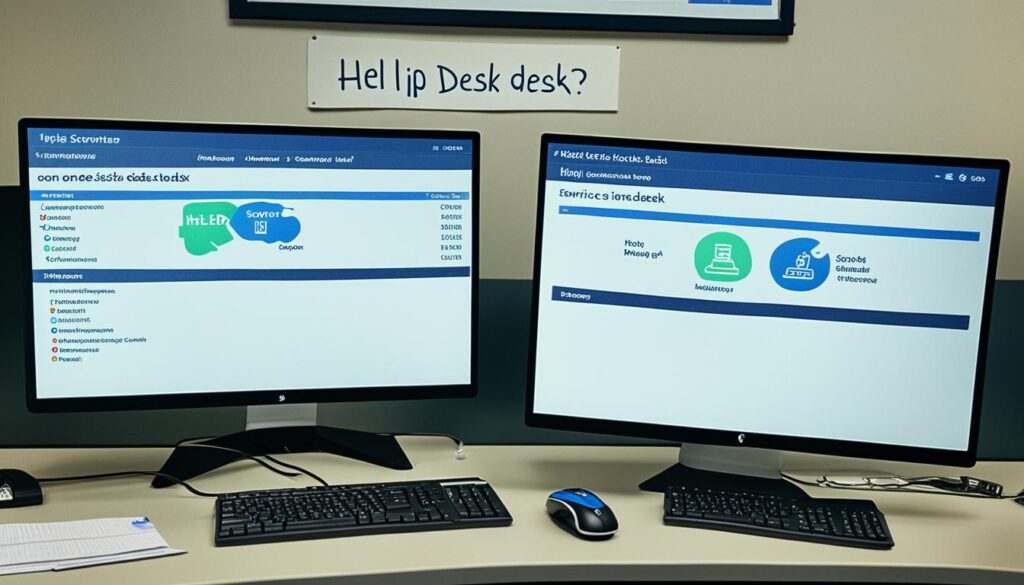Welcome to our article where we will discuss the key differences between help desks and service desks in the realm of IT support. If you are involved in the IT industry or require technical assistance, understanding the distinctions between the two will be invaluable to your business or organization.
Before we delve into the nuances of help desks and service desks, it is crucial to define their roles according to ITIL (Information Technology Infrastructure Library) standards. A service desk serves as the central point of contact between service providers and users, managing incidents, service requests, and user communication. It is a comprehensive hub that encompasses activities such as service request management, incident management, knowledge management, self-service options, and reporting.
On the other hand, a help desk focuses primarily on troubleshooting and resolving immediate IT issues. It provides reactive support to address short-term user issues as they arise. Help desks are more focused on fixing specific user problems and are typically not involved in the larger scope of proactive solution development.
In the following sections, we will explore the differences between help desks and service desks in more depth. We will also discuss the importance of both in the context of IT support for businesses. So, let’s dive in and gain a clear understanding of these crucial components of IT infrastructure.
Help Desk vs Service Desk: What’s the Difference?
Help desks and service desks play critical roles in any IT support strategy. Understanding their differences is essential for businesses to optimize their support processes and meet the needs of their users. While both help desks and service desks aim to improve customer satisfaction and provide efficient support, they have distinct approaches and scopes of operation.
A help desk is primarily focused on troubleshooting and resolving immediate IT issues. It offers reactive support, addressing specific user problems as they arise. Help desks are the go-to point of contact for users experiencing technical difficulties and require quick solutions.
On the other hand, a service desk provides a complete end-to-end service, handling a broader range of IT support activities. It takes a proactive approach to improve the entire support process and develop long-term solutions. Service desks not only troubleshoot and resolve immediate issues but also work on preventive measures, root cause analysis, and problem management to eliminate recurring problems.
Both help desks and service desks have common goals, including improving customer satisfaction, providing fast support, saving time through self-service options, enabling smarter decisions based on analytics, and eliminating manual tasks for increased efficiency. However, they differ in their focus and scope:
- A help desk primarily focuses on immediate issue resolution.
- A service desk provides broader support activities and aims for continuous service improvement.
- A help desk offers reactive support, addressing specific user issues as they occur.
- A service desk takes a proactive approach, identifying potential issues and developing long-term solutions.
Ultimately, businesses should choose the right support approach based on their specific needs. While smaller organizations may benefit from a help desk model, larger enterprises with complex IT environments might require a service desk for comprehensive support and process improvement.

By selecting the most appropriate support approach and leveraging the right tools, businesses can ensure smooth IT operations, enhanced customer satisfaction, and optimized productivity.
Importance of Help Desks and Service Desks
Help desks and service desks play a crucial role in enhancing employee productivity, improving retention rates, and ensuring operational efficiency. With their comprehensive IT support capabilities, they provide valuable assistance to both end users and organizations. Let’s explore why these support centers are essential for a successful IT environment.
Boost Employee Productivity and Prevent Churn
Help desks and service desks streamline workflow management by promptly addressing IT issues and service requests. By providing quick and reliable support, they minimize downtime and enable employees to perform their tasks efficiently. This optimized workflow not only improves productivity but also contributes to higher employee satisfaction and lower turnover rates.
Improve Business Operations and End User Satisfaction
IT support centers equipped with advanced tools and technologies deliver actionable insights through analytics. By analyzing trends and patterns, these centers help organizations identify areas for improvement and make smarter decisions based on data-driven strategies. Additionally, by providing faster support and resolving issues promptly, help desks and service desks enhance end user satisfaction, resulting in a positive overall experience.
Save Time and Enable Efficient Collaboration
Help desk and service desk solutions facilitate streamlined collaboration among IT support teams by centralizing communication channels and providing a unified platform for ticket management. This cohesive approach not only saves time but also ensures transparency and accountability in resolving IT incidents and service requests. The ability to collaborate efficiently results in faster resolutions and improved customer support.
Enable Self-Service and Eliminate Manual Tasks
Modern help desk and service desk software includes self-service portals that empower end users to resolve common IT issues independently. By enabling self-service at scale, organizations can reduce the burden on support teams, allowing them to focus on more complex tasks and strategic initiatives. Additionally, these software solutions automate manual tasks, such as ticket assignment and notification management, further improving operational efficiency.
By utilizing help desks and service desks, organizations can optimize their IT support strategies, enhance customer satisfaction, and drive business success. These support centers provide valuable assistance to both end users and IT teams, ensuring a seamless IT experience and a productive working environment.
| Benefits of Help Desks and Service Desks |
|---|
| Faster issue resolution |
| Improved end user satisfaction |
| Streamlined collaboration among IT teams |
| Efficient workflow management |
| Actionable insights through analytics |
| Enhanced employee productivity |
| Reduced downtime |
| Empowered self-service capabilities |
| Elimination of manual tasks |

Conclusion
In conclusion, when comparing help desks and service desks, it is important to recognize their distinctive roles and responsibilities in IT support. Help desks specialize in addressing immediate IT issues and providing reactive support, focusing on resolving specific user problems. On the other hand, service desks offer a more comprehensive approach, taking a proactive stance to improve the overall IT support process and develop long-term solutions.
Both help desks and service desks are vital components of an effective IT support strategy. Help desks excel at quickly resolving user issues, ensuring customer satisfaction, and delivering fast support. Service desks, on the other hand, go beyond troubleshooting by incorporating incident management, service request management, knowledge management, self-service options, and reporting.
By leveraging the right help desk software or service desk software, businesses can optimize their IT support centers, streamline workflows, and meet the diverse needs of their users. Balancing reactive and proactive support, organizations can enhance operational efficiency, boost employee productivity, and ultimately improve customer satisfaction. Whether you require immediate problem-solving or a complete end-to-end service, help desks and service desks play critical roles in delivering exceptional IT support.
FAQ
What is the difference between a help desk and a service desk?
A help desk primarily handles immediate IT issues and provides reactive support, while a service desk offers a complete service and takes a proactive approach to IT support. Help desks focus on troubleshooting and fixing specific user issues, while service desks manage incidents, service requests, communication with users, and aim for proactive solution development.
What activities do service desks and help desks encompass?
Service desks handle a wider array of IT support activities, such as service request management, incident management, knowledge management, self-service, and reporting. Help desks are primarily focused on troubleshooting and fixing immediate IT issues, offering reactive service for short-term user issues.
How do help desks and service desks differ in their approach?
Help desks are more reactive in nature, addressing specific user issues as they arise. In contrast, service desks take a proactive approach, aiming to improve the entire support process, develop long-term solutions, and provide a complete end-to-end service.
What role do help desks and service desks play in an IT support strategy?
Help desks and service desks are critical in enhancing employee productivity, improving retention rates, and ensuring operational efficiency. They streamline workflow management, automate manual tasks, provide insights through analytics, improve end-user satisfaction, enable self-service, and deliver faster support.
What benefits do help desk and service desk tools offer?
Help desk and service desk tools offer a range of benefits, including making smarter decisions based on data, improving satisfaction for end users, saving time, encouraging collaboration, enabling self-service, and eliminating manual tasks.
How can businesses effectively manage their help desk or service desk?
Businesses can effectively manage their help desk or service desk by leveraging the right tools, optimizing workflows, fostering collaboration among support agents, implementing self-service options for users, and using analytics to measure performance and make data-driven decisions.
